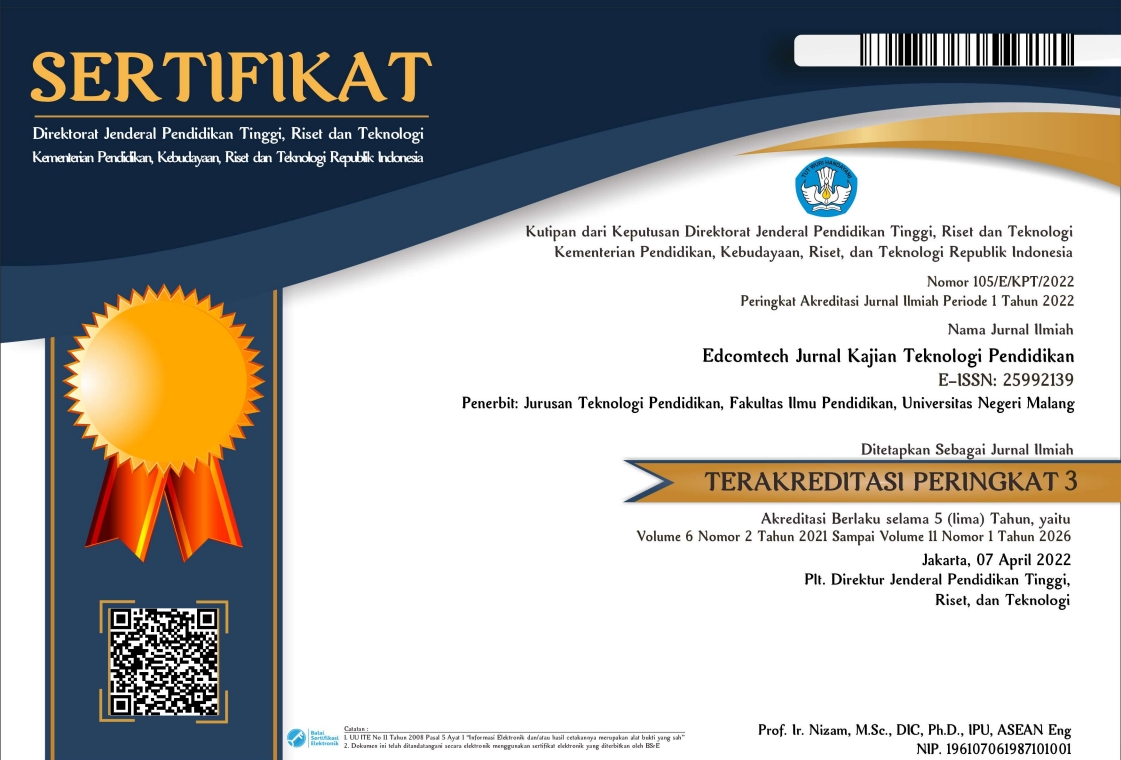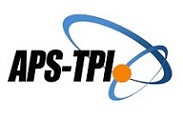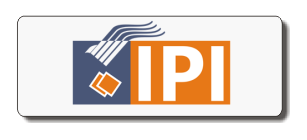Implementasi Model Pembelajaran Flipped Classroom Guna Meningkatkan Interaksi Belajar Mahasiswa pada Mata Kuliah Manajemen Informasi dan E-Administrasi
Abstract
Abstrak: Penelitian ini bertujuan untuk mengidentifikasi efektivitas interaksi mahasiswa dalam pembelajaran mata kuliah Manajemen Informasi dan E-Administrasi dengan menggunakan metode flipped classroom (Kelas terbalik). Teori Moore (1989) dan Hillman et al., (1994) digunakan dalam menentukan empat model interaksi belajar mahasiswa baik di kelas maupun di luar kelas. Empat interaksi tersebut antara lain adalah interaksi antara peserta ajar (mahasiswa), interaksi antara peserta ajar dengan pengajar, interaksi antara peserta ajar dengan materi ajar dan interaksi anatara peserta ajar dengan media teknologi. Penelitian ini dilakukan dengan menggunakan pendekatan penelitian metode campuran. Kuesioner dan wawancara individu digunakan untuk mengumpulkan data. 29 responden dari peserta ajar diberikan kuesioner pada akhir semester dan 10 dari mereka dipilih untuk dilakukan wawancara secara individu. Data yang terkumpul dianalisis menggunakan statistik deskriptif dan analisis data menggunakan SPSS. Hasil penelitian ini menunjukkan bahwa peserta ajar memiliki persepsi positif dalam semua komponen interaksi dalam pembelajaran mata kuliah Manajemen Informasi dan E-Administrasi menggunakan menggunakan metode flipped classroom. Output dari penelitian ini telah memberikan kontribusi bagi sebuah perguruan tinggi dalam mengimplementasikan digital pembelajaran inovatif flipped classroom dengan menggunakan media WhatsApp dan YouTube.
Abstract: This study aims to identify the effectiveness of student interaction in learning Information Management and E-Administration courses using the flipped classroom method. The theory of Moore (1989) and Hillman et al., (1994) was used in determining four models of student learning interactions both in class and outside the classroom. The four interactions include interactions between teaching participants (students), interactions between teaching participants and teachers, interactions between teaching participants and teaching materials and interactions between teaching participants and technology media. This research was conducted using a mixed methods research approach. Questionnaires and individual interviews were used to collect data. 29 of the teaching participants were given a questionnaire at the end of the semester and 10 of them were selected to be interviewed individually. The collected data were analyzed using descriptive statistics and data analysis using SPSS. The results of this study indicate that the teaching participants have positive perceptions in all components of the interaction in learning the Information Management and E-Administration courses using the flipped classroom method. The output of this research has contributed to a university in implementing innovative digital learning flipped classrooms using WhatsApp and YouTube media.
Full Text:
PDFReferences
Ainin, S., Naqshbandi, M. M., Moghavvemi, S., & Jaafar, N. I. (2015). Facebook usage, socialization and academic performance. Computers & Education, 83, 64-73.
Asfar, N., & Zainuddin, Z. (2015). Secondary students' perceptions of information, communication and technology (ICT) use in promoting self directed learning in Malaysia. The Online Journal of Distance Education and E-Learning, 3(4), 67-82.
Asikainen, H., Blomster, J., & Virtanen, V. (2018). From functioning communality to hostile behaviour: students’ and teachers’ experiences of the teacher–student relationship in the academic community. Journal of Further and Higher Education, 42(5), 633-648.
Bergmann, J., & Sams, A. (2014). Flipped learning: Maximizing face time. T+D Magazine, 68(2), 28-31.
Blau, I., & Shamir-Inbal, T. (2017). Re-designed flipped learning model in an academic course: The role of co-creation and co-regulation. Computers & Education, 115, 69-81.
https://doi.org/10.1016/j.compedu.2017.07.014.
Burke, A. S., & Fedorek, B. (2017). Does “flipping” promote engagement?: A comparison of a traditional, online, and flipped class. Active Learning in Higher Education, 18(1), 11-24.
Chuang, H. H., Weng, C. Y., & Chen, C. H. (2018). Which students benefit most from a flipped classroom approach to language learning?. British Journal of Educational Technology, 49(1), 56-68.
Cilliers, L. (2017). Wiki acceptance by university students to improve collaboration in higher education. Innovations in Education and Teaching International, 54(5), 485-493.
Clark, K. R. (2015). The effects of the flipped model of instruction on student engagement and performance in the secondary mathematics classroom. Journal of Educators Online, 12(1), 91-115.
Collins, A., & Halverson, R. (2018). Rethinking education in the age of technology: The digital revolution and schooling in America. Teachers College Press.
Creswell, J. W. (2008). Educational research: Planning, conducting, and evaluating quantitative and qualitative research (3rd ed.). Upper Saddle River, NJ: Prentice Hall.
de Araujo, Z., Otten, S., & Birisci, S. (2017). Mathematics teachers' motivations for, conceptions of, and experiences with flipped instruction. Teaching and Teacher Education, 62, 60-70.
Esterhazy, R., & Damşa, C. (2019). Unpacking the feedback process: an analysis of undergraduate students’ interactional meaning-making of feedback comments. Studies in Higher Education, 44(2), 260-274.
Hillman, D. C. A., Willis, D. J., & Gunawardena, C. N. (1994). Learner-interface interaction in distance education: An extension of contemporary models and strategies for practitioners. American Journal of Distance Education, 8(2), 30-42.
Johnson, B., & Christensen, L. (2008). Educational research: Quantitative, qualitative, and mixed approaches. Thousand Oaks, CA: Sage.
Kim, M. K., Kim, S. M., Khera, O., & Getman, J. (2014). The experience of three flipped classrooms in an urban university: An exploration of design principles. The Internet and Higher Education, 22, 37-50.
Klassen, A. C., Creswell, J., Clark, V. L. P., Smith, K. C., & Meissner, H. I. (2012). Best practices in mixed methods for quality of life research. Quality of Life Research, 21(3), 377-380.
Lai, C., Hu, X., & Lyu, B. (2018). Understanding the nature of learners’ out-of-class language learning experience with technology. Computer Assisted Language Learning, 31(1-2), 114-143.
Lee, M. K. (2018). Flipped classroom as an alternative future class model?: implications of South Korea’s social experiment. Educational Technology Research and Development, 66(3), 837-857.
Luo, N., Zhang, M., & Qi, D. (2017). Effects of different interactions on students' sense of community in e-learning environment. Computers & Education, 115, 153-160.
Moore, M. (1989). Three types of interaction. American Journal of Distance Education, 3(2), 1-6.
Nguyen, T. D., Cannata, M., & Miller, J. (2018). Understanding student behavioral engagement: Importance of student interaction with peers and teachers. The Journal of Educational Research, 111(2), 163-174.
Patton, M. Q. (2002). Qualitative research and evaluation methods (3rd ed.). London: Sage.
Roach, T. (2014). Student perceptions toward flipped learning: New methods to increase interaction and active learning in economics. International Review of Economics Education, 1-11.
Sergis, S., Sampson, D. G., & Pelliccione, L. (2018). Investigating the impact of Flipped Classroom on students' learning experiences: A Self-Determination Theory approach. Computers in Human Behavior, 78, 368-378.
Sun, J. C. Y., Wu, Y. T., & Lee, W. I. (2017). The effect of the flipped classroom approach to OpenCourseWare instruction on students’ self‐regulation. British Journal of Educational Technology, 48(3), 713-729.
Tsai, K. C. (2017). Teacher-Student Relationships, Satisfaction, and Achievement among Art and Design College Students in Macau. Journal of Education and Practice, 8(6), 12-16.
Yang, Y., Wang, Q., Woo, H. L., & Quek, C. L. (2011). Using Facebook for teaching and learning: a review of the literature. International Journal of Continuing Engineering Education and Life Long Learning, 21(1), 72-86.
Zainuddin, Z., & Keumala, C. M. (2018). Blended learning method within Indonesian higher education institutions. Jurnal Pendidikan Humaniora, 6(2), 69-77.
Zainuddin, Z., & Perera, C. J. (2018). Supporting students’ self-directed learning in the flipped classroom through the LMS TES BlendSpace. On the Horizon, 26(4), 281-290.
Zainuddin, Z., Habiburrahim, H., Muluk, S., & Keumala, C. M. (2019). How do students become self-directed learners in the EFL flipped-class pedagogy? A study in higher education. Indonesian Journal of Applied Linguistics, 8(3), 678-690.
DOI: http://dx.doi.org/10.17977/um039v4i22019p109
Refbacks
- There are currently no refbacks.
Copyright (c) 2019 Thanthawi Ishak, Rudi Kurniawan, Zamzami Zainuddin

This work is licensed under a Creative Commons Attribution-ShareAlike 4.0 International License.
Edcomtech: Jurnal Kajian Teknologi Pendidikan published by Department of Educational Technology, Faculty of Education, State University of Malang in Collaboration with Asosiasi Program Studi Teknologi Pendidikan Indonesia (APS TPI) and Ikatan Profesi Teknologi Pendidikan Indonesia (IPTPI) with MoU.
Publisher Address:
Lab. Teknologi Pendidikan, Gd.E2, Lt.1
Fakultas Ilmu Pendidikan Universitas Negeri Malang
Jalan Semarang No 5, Kota Malang Kode Pos 65145
Email: edcomtech.fip@um.ac.id
========================================================================================================
| INDEXED BY | TOOLS | PLAGIARISM CHECK | ARTICLE TEMPLATE |
|

Edcomtech is licensed under a Creative Commons Attribution-ShareAlike 4.0 International License.
Edcomtech Statistics (Since July 13th, 2020)











1.png)








